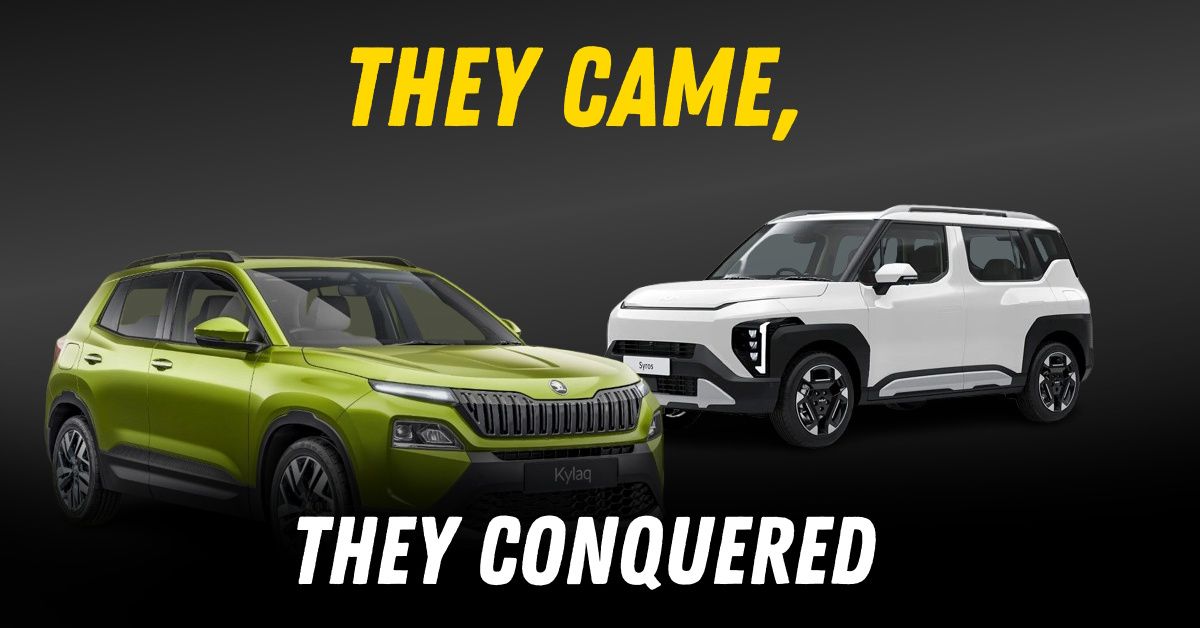Two New Launches - Kia Syros and Skoda Kylaq - Show Promise Despite Tough Competition


The compact SUV segment has become even more competitive with the arrival of two fresh contenders: the Kia Syros and the Skoda Kylaq. Launched within months of each other, both models have quietly made an impact, capturing a combined 7 percent market share between January and April 2025. Together, they’ve sold over 35,000 units in that period, indicating strong early traction in an otherwise saturated space.
Although they occupy the same segment, the Syros and Kylaq represent vastly different approaches. Kia’s Syros came out of the gate strong, with over 5,500 units sold in its very first month. Since then, it has maintained a steady pace, consistently clocking over 4,000 units each month. For Kia, this is a notable achievement: the Syros already contributes more than a fifth of the company’s total monthly volumes and ranks as their fourth best-selling product.
The Kylaq’s entry was far more muted, managing just over 1,200 units in January. But Skoda seems to have played the long game. By April, sales had grown to more than 5,300 units. The Kylaq has now become Skoda’s top-seller, accounting for nearly two-thirds of the brand’s India sales. That’s a remarkable shift for a carmaker that has often struggled with scale in the Indian market.
The Syros is capitalising on Kia’s extensive dealership and service footprint, and also benefits from strong brand equity built by the Seltos and Sonet. With prices ranging from ₹9 lakh to ₹17.8 lakh, it targets the upper end of the compact SUV bracket. The tall-boy design translates into generous cabin space, especially in the rear, where three adults and a child can reportedly sit without feeling cramped which is an important consideration for family buyers.
Kia has positioned the Syros as a comfort-first urban SUV. Features like rear-seat ventilation, sliding and reclining rear bench, a panoramic sunroof, and Level 2 ADAS tech have helped it stand out. While this places it in direct contention with some midsize SUVs, the initial response indicates that buyers are willing to pay for thoughtful packaging and segment-first conveniences.
In contrast, the Kylaq has focused on value. Starting at ₹7.89 lakh, it undercuts most competitors and appeals to those prioritising price without compromising on core strengths. Built on the same platform as the Kushaq, it offers a similar driving experience and retains Skoda’s reputation for solid build quality and composed dynamics. Its 5-star safety rating under Bharat NCAP adds to its appeal among cautious buyers.
The Kylaq also seems to be finding success beyond metro markets, where brand familiarity and European design now carry more weight than before. However, the single-engine offering, a 1.0-litre turbo-petrol, limits choice for buyers looking for diesel or hybrid alternatives.
Neither SUV is without its limitations. The Syros, while well-equipped, faces the challenge of justifying its premium pricing in a value-driven segment. Its distinctive styling may also divide opinion, especially among those seeking more traditional SUV proportions.
The Kylaq, meanwhile, is constrained by Skoda’s smaller service network and a limited dealership footprint. While interest in the vehicle is growing, especially in smaller cities, concerns around after-sales support and long-term cost of ownership continue to shape buyer sentiment. High demand has also led to waiting periods stretching to nearly five months for some variants, testing consumer patience.
What both models demonstrate is that there is no single formula for success in this segment anymore. The Syros shows that compact SUVs can move upmarket if they deliver genuine, family-focused innovation. Its segment-first features may well push rivals to follow suit.
The Kylaq proves that European carmakers can offer accessible, locally optimised products without diluting their identity. Its pricing and safety credentials provide a compelling alternative to Japanese and Korean rivals, especially for buyers who have traditionally avoided premium European brands due to cost concerns.
In a category long dominated by the likes of the Maruti Brezza and Hyundai Venue, these two new entrants are already reshaping the landscape. While neither has achieved runaway success just yet, both the Syros and Kylaq are steadily building a presence that looks increasingly sustainable. As production stabilises and word-of-mouth grows, their market share is likely to expand further.